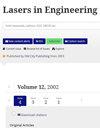修正了阿秒激光脉冲与物质相互作用的schrödinger方程
IF 0.6
4区 工程技术
Q4 MATERIALS SCIENCE, MULTIDISCIPLINARY
引用次数: 9
摘要
最近发表了接近阿秒边界的x射线脉冲测量(M. Drescher et al ., Science 291 (2001) p. 1923)。阿秒激光脉冲使研究和控制原子内电子的运动成为可能。本文建立并求解了描述原子中电子与周围环境相互作用的修正薛定谔方程(MSE)。这种相互作用只能在10阿秒量级的相互作用弛豫时间内使用阿秒激光脉冲来检测。本文章由计算机程序翻译,如有差异,请以英文原文为准。
Modified schrödinger equation for attosecond laser pulse interaction with matter
Recently the measurement of X-ray pulses approaching the attosecond frontier was published (M. Drescher et al ., Science 291 (2001) p. 1923). The attosecond laser pulse enables the study and control of the motion of electrons inside atoms. In this paper we develop and solve the modified Schrodinger equation (MSE) which describes the interaction of electrons with its surroundings in an atom. This interaction can be detected only using an attosecond laser pulse within the relaxation time of the interaction which is of the order of 10 attoseconds.
求助全文
通过发布文献求助,成功后即可免费获取论文全文。
去求助
来源期刊

Lasers in Engineering
工程技术-材料科学:综合
CiteScore
1.00
自引率
20.00%
发文量
0
审稿时长
3.4 months
期刊介绍:
Lasers in Engineering publishes original (primary) research articles, reviews, short communications and letters on all aspects relating to the application of lasers in the many different branches of engineering and related disciplines.
The topics covered by Lasers in Engineering are the use of lasers: in sensors or measuring and for mapping devices; in electrocomponent fabrication; for materials processing; as integral parts of production assemblies; within the fields of biotechnology and bioengineering; in micro- and nanofabrication; as well as the materials and processing aspects of techniques such as cutting, drilling, marking, cladding, additive manufacturing (AM), alloying, welding and surface treatment and engineering.
Lasers in Engineering presents a balanced account of future developments, fundamental aspects and industrial innovations driven by the deployment of lasers. Modern technology has a vitally important role to play in meeting the increasingly stringent demands made on material and production systems. Lasers in Engineering provides a readily accessible medium for the rapid reporting of new knowledge, and technological and scientific advances in these areas.
 求助内容:
求助内容: 应助结果提醒方式:
应助结果提醒方式:


